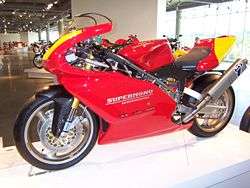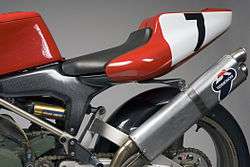Ducati Supermono
 | |
| Manufacturer | Ducati |
|---|---|
| Production | 1993-1997 ( 65 built 93'-95', 2 built 96'-97' ) Total 67 |
| Engine |
549/572 cc 4-valve desmodromic single 12:1 compression ratio Weber fuel injection bore x stroke: 100 mm x 70 mm |
| Top speed | 141 mph (227 km/h) |
| Power | 61.4 hp (46 kW) @ 9750 rpm |
| Torque | 37 lb·ft (50 N·m) @ 8000 rpm |
| Transmission | 6-speed |
| Brakes | Dual 11-inch, 4-piston Brembo disc |
| Weight |
267 pounds (121 kg) (dry) 277 lb (126 kg) (wet) |
The Ducati Supermono is a lightweight, single-cylinder racing motorcycle made by Ducati. It is named for the Supermono racing class. The Supermono is arguably one of the most collectable Ducatis in any era. Only 65 Supermonos were built by Ducati between 1993 and 1995.
Technology

This lightweight, compact racer was built with many technical innovations that strongly influenced the design of the 916, one year later.
The single cylinder Ducati racer was built with power to weight in mind. Carbon fiber pieces included bodywork, sub frame, fuel tank, rear sets, airbox and instrument housing. Magnesium was used for case covers, chain adjustment covers and triple clamps. Dry weight was 267 pounds (121 kg).
42mm Ohlins inverted telescopic forks were used, similar to those used on the Ducati 888 Corsa. Other notable components include a cantilevered Ohlins DU2041 shock absorber, Termignoni exhaust and 3 spoke Marchesini magnesium wheels. The front brakes were Brembo 280 mm fully floating iron front discs and Brembo P4. 30-34 racing calipers.
The Supermono inherited many of its features from 888 Racing. Liquid cooled double overhead cam shaft with four valve desmodromic cylinder head. A horizontally placed 550cc cylinder utilized a "dummy connecting rod" that acted like a second piston in terms of making the dynamic balance equivalent to a ninety degree Vee twin. This ingenious engineering was the key to overcoming vibration problems typically handled with either balance shafts or the incomplete solution of only having a crank counterweight.
Design
Pierre Terblanche designed the look of the Supermono, with Claudio Domenicali and Massimo Bordi designing frame, power plant and other unique features.
Specifications

- Single cylinder, four stroke, liquid cooled, fuel injected
- 549cc (100 x 70mm)
- 76 bhp @ 10,500 rpm
- Weight : 267 lbs. (122 kg)
- Wheels : 17” Cast Magnesium
- Transmission: 6 speed, chain final drive
- Maximum speed: 145 mph
( hp and torque numbers tend to vary between 1993–1995, due to a 570cc version in 1995.)
Fuel and spark plugs
In the mid 1990s, 100 octane aviation gas was the fuel of choice for many Supermono race teams. Spark plugs with a 54 to 55 heat index were required. Several teams used Champion spark plug QA55V.
Race History
At the time the Supermono was designed, a European Supermono Cup existed (Sound of Singles). This was a support event to the World Superbike Championship. The Supermono was a "test bed" for the World Superbike racers.[1]
New Zealander Robert Holden was the most successful of all Ducati Supermono racers. In 1994 Holden placed second in the Isle of Man TT, then returned to the 1995 Isle of Man TT to win the singles title. Holden also won in Ireland's NW 200 Supermono class in 1995. Holden died the following year in practice at the Isle of Man TT.
References
- ↑ Ian Falloon. The Ducati Story. UK: Haynes Publishing. p. 133.
- John Burns. "CW Classics:Ducati Supermono". Cycle World. Retrieved 2014-09-25.
External links
| Wikimedia Commons has media related to Ducati Supermono. |
- Ducati Supermono at Ducati.com Heritage.